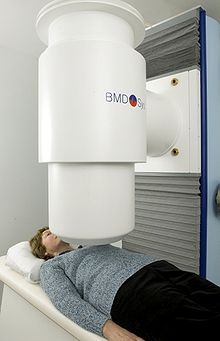Magnetic field imaging
Magnetic field imaging (MFI) is a medical examination method with no side effects, in which functional images of the heart are displayed. MFI usually uses SQUIDs , which are arranged in an array of at least 49 sensors , to record the magnetic signals . The MFI examination allows the doctor, among other things, to assess the individual risk of a patient for the occurrence of life-threatening cardiac arrhythmias, which can lead to sudden cardiac death . Other possible uses are in ischemia diagnostics .
The magnetic signals go hand in hand with the electrical currents that flow to control and stimulate the muscle cells. In contrast to electrical currents, however, the magnetic signals leave the body almost unaffected and also transport additional information that does not reach the body surface with the electrical signal.
Medical benefit
The MFI seems to be able to detect a tendency for possibly life-threatening cardiac arrhythmias in selected patients in some cases . So far, however, there is still a lack of convincing evidence, e.g. B. by multicenter studies , which is surprising since the process has been scientifically described since 1981. A further therapeutic measure such as the preventive implantation of a defibrillator (ICD) is by no means currently indicated on the basis of the MFI examination . The corresponding guidelines therefore do not list the procedure as a meaningful diagnostic measure.
An MFI investigation must currently be classified as an experimental procedure. Research is carried out in the following areas:
For people who
- have already survived cardiac arrest caused by life-threatening cardiac arrhythmias,
- have a close relative who has suffered sudden cardiac death
- have already had a heart attack
- suffer from a weak heart.
Function of the MFI process
The functional principle of the MFI is very similar to that of the MEG . During the examination, around 50 highly sensitive sensors, which are cooled to −269 ° C by liquid helium, record magnetic signals from the heart and recognize the electrical activity. The 30 cm diameter sensor head is placed over the patient's heart without touching it. Within a few minutes, the MFI records and analyzes the magnetic signals emitted by the beating heart and then evaluates them with the aid of a computer. Magnetic field imaging differs from magnetocardiography , which uses a similar recording technique, primarily through the full integration of the multi-channel sensor into the complex mathematical evaluation of the data. In simple terms, MFI can be described as the clinically usable advancement of magnetocardiography.
For the patient, the MFI exposure is extremely uncomplicated, quick and safe; only metallic objects have to be put down, otherwise no special preparation is required.
literature
- HP Müller, P. Gödde, K. Czerski, M. Oeff, R. Agrawal, P. Endt, W. Kruse, U. Steinhoff, L. Trahms: Magnetocardiographic analysis of the two-dimensional distribution of intra-QRS fractionated activation. In: Physics in Medicine and Biology 44, 1999, pp. 105-120.
- P. Korhonen, T. Husa, I. Tierala, H. Vaananen, M. Makijarvi, T. Katila, L. Toivonen: Increased intra-QRS fragmentation in magnetocardiography as a predictor of arrhythmic events and mortality in patients with cardiac dysfunction after myocardial infarction. In: Journal of Cardiovascular Electrophysiology 17 (4), 2006, pp. 396-401.
- W. Andrä, H. Nowak (Ed.): Magnetism in Medicine: A Handbook. 2nd Edition. Wiley-VCH, Weinheim 2006, ISBN 3-527-40558-5 .
Web links
- Asklepios Klinik St. Georg, Hamburg Clinic in Hamburg that operates an MFI system
- BMDSys, Biomagnetic Diagnostic Systems Jena Description of an MFI system
